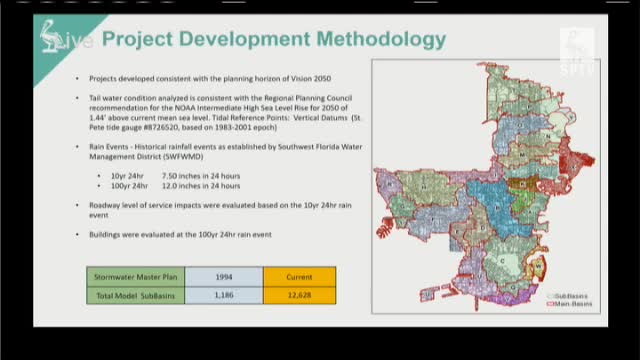City unveils ambitious flood management plan for future resilience
July 25, 2024 | Saint Petersburg City, St. Petersburg County, Florida

This article was created by AI summarizing key points discussed. AI makes mistakes, so for full details and context, please refer to the video of the full meeting. Please report any errors so we can fix them. Report an error »

In a recent government meeting, officials discussed significant flood management projects aligned with the Vision 2050 planning horizon, which anticipates a sea level rise of 1.4 feet by 2050. The meeting highlighted the modeling of various rainfall events, including 10-year and 100-year, 24-hour scenarios, to assess road service levels and structural damage risks.
The officials emphasized that the projects are designed for regional benefits rather than localized solutions, addressing multiple flood concerns across the city. Public input was gathered through various channels, including community meetings and online platforms, which helped identify areas of concern. The data collected was used to prioritize projects based on empirical criteria, ensuring that the most pressing needs are addressed effectively.
One notable project discussed involves a $600,000 investment aimed at removing 19 structures from the 100-year floodplain, showcasing the potential for substantial regional impact at a relatively low cost. In contrast, larger projects, such as one estimated at over $9.5 million, are also in the pipeline, with the cost playing a crucial role in project ranking and prioritization.
The meeting also touched on funding strategies, with officials noting the importance of leveraging alternative funding opportunities. Recent efforts have resulted in securing grants that could significantly reduce the financial burden on city funds, with potential savings of up to $26 million for various projects.
Overall, the discussions underscored a proactive approach to flood management, focusing on long-term resilience and community safety in the face of climate change challenges.
The officials emphasized that the projects are designed for regional benefits rather than localized solutions, addressing multiple flood concerns across the city. Public input was gathered through various channels, including community meetings and online platforms, which helped identify areas of concern. The data collected was used to prioritize projects based on empirical criteria, ensuring that the most pressing needs are addressed effectively.
One notable project discussed involves a $600,000 investment aimed at removing 19 structures from the 100-year floodplain, showcasing the potential for substantial regional impact at a relatively low cost. In contrast, larger projects, such as one estimated at over $9.5 million, are also in the pipeline, with the cost playing a crucial role in project ranking and prioritization.
The meeting also touched on funding strategies, with officials noting the importance of leveraging alternative funding opportunities. Recent efforts have resulted in securing grants that could significantly reduce the financial burden on city funds, with potential savings of up to $26 million for various projects.
Overall, the discussions underscored a proactive approach to flood management, focusing on long-term resilience and community safety in the face of climate change challenges.
View full meeting
This article is based on a recent meeting—watch the full video and explore the complete transcript for deeper insights into the discussion.
View full meeting